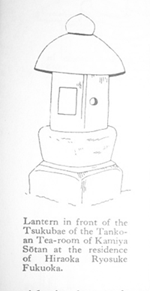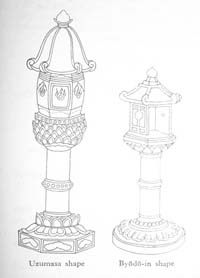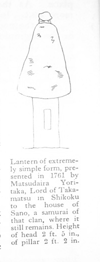Times for Cha-n-yu
茶の湯の時間
Midday may be said to be the proper time for the full ceremony with Kaiseki, but some speak of the Five Times for Tea and others of Seven.
茶の湯のすべてである懐石は昼、これは正式なものと言えます。そして、他の時間帯に行われるものが五つもしくは七つあります。
The Five Times are Midday, Morning, Dawn, Evening and Odd Times, while the Seven include one Guest Tea and After-meeting.
五つとは、昼、朝、夕方、夜そして臨時の茶事です。それに、来客と会議後の茶事が加わり七つとなります。
Yo-banashi or Evening Tea.- This follows the evening meal, and was not originally given in summer because of the discomfort caused by mosquitoes. But on cool summer evenings it was often given.
夜の茶事を夜話と言います。夕食をともなう茶の湯で夏は行われません。理由は蚊がいる為なのですが、暑くない日は例外もあります。

Asa-cha or Morning Tea.- This follows the morning meal, and if a meal is served both at this and also at the evening tea it is a lighter one than at midday.
朝に行う茶事を朝茶と言います。朝食を伴う茶の湯で、もし、夜と重複する場合はその昼よりも軽いものします。
Akatsuki or Dawn Tea.- Also called Yzumibi Cha-no-yu or Buried Embers Tea. This is because old people, who wake early in the morning, would rake out the glowing embers from under the ashes and make tea at this time. This, like the Evening meeting, was not originally given in the Winter.
早朝に行う茶事を暁と呼び、また、埋火(うずみび)の茶と言って、残り火を使うことからこの名があります。老齢な茶人は朝が早く、昨夜行われた茶の湯の炉に残る埋火をかき出して火をおこし、そして、茶の湯をします。真冬に行われることは少ないです。
Toki hazure or Tea at Odd Times.- This is given between meals, either morning, afternoon or evening.
食事の間の時間に行なわれる茶の湯を、時外れの茶事と言います。
It is usual not to serve any repast with it, but only tea and cakes.
茶とお菓子以外の食べ物は普通は出されません。
Though if the meeting be much prolonged vermicelli or any other light dish is often brought in.
さりとて、会が長引いたりした場合は、おそばや軽い食べ物は出されるようです。
Ikkyaku Isshu or One Guest and One Host.- The usual number is five, and the correct is three, but in special cases two may make a Cha-no-yu meeting.
一客一亭という茶事があり、通常は五人か三人が正式ですが特別な例としてあります。
Atomi or After meeting.- After one party o guests have been entertained another guest or guests may come, and the same utensils, picture and flowers are used a second time, and the food that remains is also consumed.
跡見の茶といい、一つの茶事が終わったのち、そこに出席しなかった人たちが来ます。道具や軸 花などすべて同じしつらえでもう一度茶事が行われるのです。もちろん、食事も同じです。
In this case either the host may invite the guests or they may ask to be allowed to came and see the utensils.
この場合、亭主は控えめな招待をし、呼ばれた客は取り合わせを拝見したい旨を伝え承諾をえるわけです。

Until the days of Rikyu people had only two meals a day, the first or morning meal at the hour of the Snaka(9 o'clock), and the evening meal at dusk.
利休の時代頃は、人々の食事は朝9時ごろと夕時の二回だけでした。
So originally morning Cha-no-yu was now at the former hour, but now there are three meals it is held after 12 moon. Evening tea was subtitle, as above.
よって、茶の湯は朝茶がもっとも正式なものとされていたのです。現在は正午が一般的で、夜は特別な扱いになっています。
According to Furuta Oribe, Sho-o used to say that evening was not a very suitable time for entertaining distinguished guests or people one was particular about at Cha-no-yu, since it was inconvenient and not good for digestion.
紹鴎や古田織部は夜の茶事はその特権階級に属する人たちにとってはけして好ましいことではないと言っています。その一つに寝る前の飲食について、茶と飲食の消化をあげています。
Moreover one could not see the dust or dirt, and that also was bad.(Cha-no-yu roku-so-denki.)
さらに夜道の不便さも上げています。
At night water should not be sprinkled in the Roji.
夜には露地に水はまきません。
The host should go out with an Andon to meet his geusts. He puts the Andon down on the seat, and the chief guest takes it up and sets it down by the water-basin while he washes his hands.
亭主は行灯を持ち客を迎えます。彼は椅子のところに行灯を置き、そして、正客が手を清めるために手水鉢へ行くときに持ってそこへ置きます。
Inside the Tea-room a "Tankei" or lamp on a stand is used. It may be put in various places, and if the Tokonoma be a famous one it is better to inspect it with a hand candlestick.
茶室の中では"短けい"という明かりを使います。床の間の軸を拝見するときには手蜀というものを使います。

At an evening Cha-no-yu the lanterns that stand by the path of the Roji should all be lighted, and those in the shade of the trees should be lighted too, for that gives an interesting effect.
夜の茶会では露地は灯篭にによって明かりがともされ、木々の陰などにも光があたり演出させます。この雰囲気はとても重要な効果を与えるのです。
On the seat of the Arbour there should be a lighted Andon and by the sword-rack on its proper stone a lighted candlestick. (Teshoku.)
待合の腰掛には明かりのついた行灯と刀掛けがおかれ、主石の上に手燭が置かれています。
On the floor of the Tea-room the Tankei with an oil lamp is used, and there should be one and a half to two inches. (Kobori Enshu.)
茶室には油に火がともされた短けいがおかれています、約50cmぐらいの高さです。
But with stone lanterns three or five threads are proper in the clay saucer, according to the size of the lantern. (Nanbo Roku.)
南方禄によれば、石灯籠は約90cmから1.5mぐらいのところに油火を置くのが正しいと規定されています。
Sometimes a Kakemono is used at evening meetings and sometimes not. Rikyu and Oribe are both of the opinion that a formal evening Cha-n-yu is not a thing to be given frequently.
夜の茶の湯において、床に軸を掛けることはケースバイケースです。利休や織部はあまり推奨はしていませんでした。
Cha-no-yu given in snow or rain has special features.
茶の湯において雨や雪は特別な場を持っています。
A large straw hat like an umbrella of which the wearer forms the stick, is provided for each person and also a pair of clogs.
棒のような藁でできたものを傘として使い下駄をはいています。
The sojourn in the arbour is as short as may be in the cold weather, and a water basin in this arbour is substituted for the one in the open.
雨宿りとしての待合と見たてて、待合の中の手水鉢は着替えるときに利用されているのです。
In very snowy province a path may be made beside the stepping stones owing to the difficulty of walking on them.
雪の多い地方では、たぶん、露地の敷石は踏まずに横を通っているのではないでしょうか。すべりやすく危険です。
At meetings for snow scenery and also for those when the moon is to be viewed, paper and writing brushes are provided in the arbour for the poems which guests will be moved to write in celebration of these beauties, and on the latter occasion lights are naturally not put in the lanterns, except perhaps where heavy foliage may cast a deep shadow.
雪の日やまた月夜には待合に筆記具が置かれています。感性によって歌が読まれ、それが作品として書き残されます。月の光は灯篭の日を必要とせず、木々の葉は深い影を作り出すのです。
At a Moon-viewing Cha-n-yu no flowers should be used. The expression Setsu-get-ka (Snow Flowers Moon) is the conventional phrase for beautiful things and a man of taste prefers to break such a cliche. A flower Tea for some special flower is known, but rare, as might be expected.
月見の茶の湯において花は使われません。雪月花は美しさの定番としてあり、茶人は陳腐を避けるのです。月下美人と言う特別な花はありますが、見ることはまれです。
When the guest has finished inspecting the Kakemono with the candlestick (Teshoku), he should put it down on the utensils mat with its handle turned to the host.
客が軸を賞味したあと、その手燭は道具畳へ置かれて亭主へ返されます。

The host comes out and takes it with the proper salute and trims the wick, and then proceeds to make up the hearth.
亭主は進み出て正式な礼をし、芯を整えて、炉の準備をはじめます。
The Teshoku should be held by the two feet and not by the third, which is sometimes called the handle, because so it is less likely to tilt and spill the grease. The Teshoku should be placed where it is convenient to illumine the hearth.
手燭は約60cmから少し上へ持ち上げられます。手燭の手の字は取っ手という意味で油を注ぐ役目よりはむしろ、炉の景色を照らし出す役目があります。
The Tankei is to be placed on the 11th or 12th line of the mat from the hearth, or, according to same, on the 9th.
短けいは炉から畳の目12から13ほどのところへ置かれます。また、9目の場合もあります。
It must be understood that the Tankei is to give light to the room generally and so is to be put where it will best do so and not get in the way of the guests.
短けいは一般的に茶室全体を照らすもので一番それにふさわしい場所へ置かれます。けして、客の都合のよい場所というわけではありません。
The Teshoku, on the other hand, is to light the hearth and not the room.
対して、手燭はさまざま都合のよいところへ移動する役目をになっています。
A Kakemono with large characters of a definite type that is easily seen without special lighting is to be used.
軸のうち、わかりやすく見やすいものは明かりは必要としません。
It is objectionable if the picture is cut in half by a shadow and so the light should be arranged so that it is either all in the light or entirely in shadow. In the matter of food also, dishes with small bones and so on should be avoided. (Konoe Iehiro in Kwai-ki.)
掛け物か絵の場合、半分しか見えないようでは困るので全体が見えるように工夫されます。食事の場合は見えにくいので、小さな骨があるようなものは避けられます。
Cha-no-yu at Dawn. - The Roji must be sprinkled with water the evening before and the lanterns and Andon lighted and then put out, and then lighted again at arbour four o'clock in the morning.
暁の茶の湯は、露地には晩のうちに水をまいておきます。そして、灯篭と行灯に明かりをともし位置へ置いておき、朝4時ごろもう一度しつらえなおします。
The kettle is also prepared the night before, and when the guests appear in the Waiting Arbour one or two sticks of charcoal are put on and the water changed in the basin.
釜もやはり前夜にその準備をしておきます。客が待合へ現れた時のタイミングを見計らって、煙草盆の用意と手水鉢の水も新しく換えるようにします。
When the guests arrive Sake and Zenzai or soup of red beans with rice-cake in it, and Mochi (rice-cake) are offered to them.
到着した客にはお酒とゼンザイがふるまわれます。ぜんざいとはあずきのスープにお餅が入ったものです。
The Ushucha is made in a leisurely fashion to the accompaniment of quiet conversation.
薄茶は静かな会話の手助けの役目であり、ゆったりした時間をつくりだします。
This over, the kettle is taken out and filled up and brought back wet and put on again.
時の流れの中、釜はいったん下げられて、湯を満たしぬれた状態で再び炉にかけられます。
Only a part of the water in it should be changed or it will boil too slowly.
湯を沸かす音だけが聞こえるゆったりとした時間です。
When the hearth is made up and the meal served the window is opened and the Andon put out, for it will now be growing light.
炉が整えられ、食事が出され、そして窓が開けられ行灯はその用を終了します。うす明かりが窓のそとに現れてくるのです。
But one should not be in too great hurry to do this, or the proper effect will not be gained.
急いではいけません、意図するところは得ることはできません。
It is rather interesting to serve the meal just when the light is still dim, and for the host to call out to the guests the name of the dish.
食事はまだ暗がりの時に出すのが重要で、亭主は食事の名を客に告げるのです。
If it is not easy for the host to get to the window then the Shoji may be opened instead.
本当の食事とは、窓、障子を開けること、とても難しい演出が必要なのです。
The opening and shutting of the windows is a thing that reveals an experienced host.
窓の開け閉めのタイミングは、亭主の熟練を指し示します。
Sometimes the upper windows should be opened, and sometimes the lower. It depends on the moonlight. When the moonbeams shine in there should be no light visible inside the room. (Konoe Iehiro.)
窓は開け閉めが重要で月の光に応じて微妙に調整されます。月の光だけで室内が満たされる場合もあるのです。
Between Meal Tea, or Cake Tea. - This is a Cha-n-yu without any meal. Also called Impromptu Tea. The ceremony is much the same with the necessary abbreviations. There is no Interval (Nakadachi), thought the garden and utensils are inspecting by the guests as usual.
食の間の茶の湯、お菓子の茶、これは食事の無い茶の湯のことを言います。また、即席の茶と言います。必要最小限度の茶の湯だけを行うもので、中立などはありません。庭や道具を拝見するためだけに催されるのが普通です。
It is related that Abe Shinano-no-kami, though very fond of Cha-n-yu, never gave any but this abbreviated form. And to indicate this fact he called his Tea-room Han-go-an, or Between Meal Hut.
あべしなのの守という人物かいて、彼は茶の湯の達人だったとは思いますが、簡略した形を残しています。それはHan-go-anという茶室で間食小屋と言う意味です。
Tea with only one guest is much the same, but here the host takes care not to leave his guest by himself for long. When he goes out for a while into the Mizuya he may ask the guest to arrange the flowers to keep him occupied.
亭主と客が一人っという茶の湯もあります。亭主は水屋に下がることはなく長い時間客と対しています。下がる時は客に花のしつらえを頼む時だけです。
Twilight Tea is given when a guest happens to drop in about dusk.
たそがれの茶とは客がふとたそがれにやって来た時に行います。
Water Tea is that given when the host has got some specially famous water such as that of Uji, Yanagi, Amadera, Samegai, Akuoji, Kiyomizu in the Kyoto district, or Tennoji, at Osaka or Ocha-no-mizu at Edo.
名水の茶とは亭主が有名な水を手に入れたときに行う茶の湯です。京都ではUji, Yanagi, Amadera, Samegai, Akuoji, Kiyomizu です。大阪はTennoji、東京は Ocha-no-mizuが有名です。
Rustic Tea (Yagake or Fusube Cha-no-yu). - This is Cha-no-yu given out doors, the kettle being hung on a tree and pine needles kindled beneath it.
ふすべ茶と言い野外で行われる茶の湯です。釜を木に掛け松葉などを燃やし湯を沸かします。
Hideyoshi often had his Tea Masters perform it in this way.
秀吉が彼の茶頭たちにこの方法で茶の湯をさせました。
It was rather informal and a mat was spread for the guests, while the utensils were used from the box in which they were carried. This box is like a small Doko or Utensils Cabinet.
正式なものではなく、簡易マットが客の為に敷かれて道具類は洞庫のような箱に入れられています。
Of course the utensils are taken out and used according to the usual order. In fact the treatment of the kettle is the most informal part of it, for the host merely makes a heap of pine needles and puts them under it and fans them to keep the fire going. The kettle may be suspended on a bamboo tripod.
もちろん、道具は普通の茶の湯道具が使われています。釜の手入れは特に気付けなければならず、亭主は竹でしつらえた棒に釜をかけて松の葉を積み上げ火をつけます。下からあおいで火をおこして行きます。
A Censer Tea is one in which the Censer together with the Incense Box is passed round on a tray and each guest burns a piece of incense and inhales it in turn.
聞き茶はお香の香りを楽しむ茶の湯です。客は香炉を回して香りをきくことをします。
There is a special Cha-no-yu for Farewell to the Hearth at the end of the cold season and another for Welcome to the Furo.
一つの特別な茶の湯があります。炉に別れをつげ風炉にかえる時の茶事です。
The exact time for beginning to use the Furo, according to Rikyu, should be determined by the warmth of the season. If it was not warm enough to be comfortable with the Furo, but too warm for the hearth, some Chajin made a compromise by covering the hearth with its lid and putting the Furo on top of it, instead of in the usual place. As the Furo was thus in the middle of the room it gave more heat. In this case the kettle was suspended over it.
利休は暖かくなり風炉を使う時期をきちんと決めました。しかし、風炉を使うには暖かくならずに、また、炉を使うには暑すぎる日もあります。そこで、茶人達は折衷を行います。炉に蓋をしてその上に風炉を載せて使ったり、風炉の位置を変えて火を客から離したり近くしたり、それでも、もっと暖を取りたい場合は炉に釜をつるして使ったりもします。
At the end of the eight month, according to the old calendar, or the beginning of the ninth, is held the Nagori-no-Chaji or Farewell to the Old Tea, while the next party after this is called Kuchi-giri or Inauguration of the New.
旧暦の八月の終わりと九月の初め頃ですが名残の茶事というものがあります。それは古いお茶から新しいお茶に変わる時期で、新しい茶を迎えることを口切の茶事と言います。
On this occasion the Tea-jar is exhibited in the Tokonoma. Parties for Cha-no-yu given from the first day of the year to the fifteenth are called Dai-fuku-cha or Tea of Great Good Fortune.
床の間に茶壷を飾り、茶の湯の流派では新年と同様、祝賀をします。15日は大福茶とよばれています。
After this period until the summer they are known as Haru-cha or Spring Tea.
夏までのこの時期を春茶と呼びます。
INTRODUCTION-1 TITLE CONTENTS